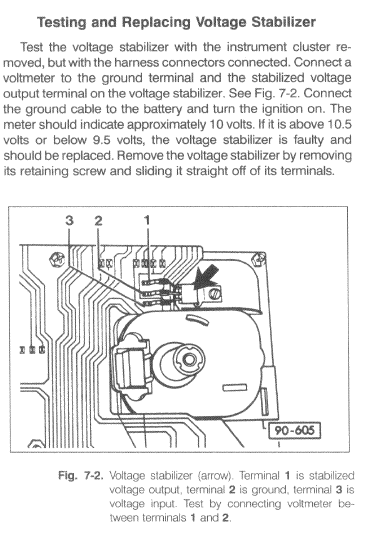wrong Temp and fuel gauge readings
Posted
#1598121
(In Topic #217305)
Settling In

Alternator problem ?
'78 Golf . When I switch the ignition, the temp and fuel gauges show correct readings . When I start the engine, the battery light won't switch off until I rev it and gauges start rising the needles . The temp goes to the top and fuel to about half . Second problem is the rev counter . It doesn't go further than 1000 RPM . Also when I start switching the lights revs drop , switch the blower , revs drop more .
Please help .
Thank you .
Posted
Local Hero

Reving the engine and getting the battery light to go out is considered normal.
If you haven't already, I would suggest that you replace the Battery to frame cable, and the Frame to engine Cable. You can get off the shelf 2 piece units from most good autoparts stores. Be sure that you get the Battery ends with a couple of take-off that you can get the ring connectors off the nuts and have less to deal with.
Second on the Cluster there are a couple of things that you can do to improve the cluster and gauges.
1. Carefully remove the shroud off the connector and uncover the mylar. Remove the mylar off the tongue. Place 1 piece of electrical tape over the tongue pin side, replace the mylar and the shroud.
2. Remove the nuts on the back of the gauges all of them one at a time. Clean and polish the brass studs with wire wool so they are bright and shiny. Clean the mylar with a pencil eraser, Do the Same steel wool trick with the nuts and replace them tight but not overtly tight. Make sure you blow all the steel wool trash off the instruments as you are finishing.
3. On the back of the cluster is a 3 pin transistor looking thing it is the 10V stabilizer.
With the cluster re-connected, and the key switch on (engine not running)… You should have 14V at one leg to the middle, and 10V to the other leg from the middle.
B+ of the battery is 11.7-12.5V and the other leg may be 9.5 to 10V.

If you have more than 10V that is a issue and the voltage stabilizer needs replacing. It is a Fairchild
KA 7810-aet which you can buy from a good electronics parts store for a dollar US or less. You can order it from online VW stores for 25-45 dollars…. (what a mark-up).
Last there is a Brown wire on the connector usually pin2 it is ground to the cluster. On the connector side of the thing Splice a wire about 12" long to the Brown wire, and wrap it with tape or use a Scotch-loc add a wire thing. I don't usually like those but for grounds they work ok.
Tale the other end of the wire and add a blue medium ring connector to it.
In between the X of the cluster brackets drill a small pilot hole, then use a piece of sand paper to scrub the paint off the pilot hole area about 1/4 inch in diameter.
Using a 3/4 inch number 6 sheet metal screw, screw the ring connector in to the pilot hole..You have just added a more direct ground to your cluster and improving your connections.
I would suspect bad connections (corroded) bad ground or a bad 10V stabilizer.
I have how do I do thats in the Archive section, How-to's
under Briano's how do I do that's on a 93 Cabriolet.
Yes I know it's a 93, but a lot of things are common between years.
What do Divorces, Great Coffee, and Car Electrics all have in common?
They all start with GOOD Grounds.
Where are my DIY Links?
They all start with GOOD Grounds.
Where are my DIY Links?
Posted
Settling In

10 pin connector has the ground on pin 4 , but the 14 pin connector has ground on 2 as you said . The brown wire is ground .
The fact is that i rebuilt the instrument cluster PCB. I am sure that I connected all the pins correctly. The only think that bothers me that I didn't cover the PCB tracks and with time they could corrode causing problems . As I remember I have changed the voltage regulator. I have tried another regulator , the same KA 7810 (not aet) but the lights and gauges went crazy . is there any difference between them ?
I will try to trace another ground to cluster and will try to replace the regulator from the inside of alternator .
Posted
Local Hero

Some of the new vendors include a brass shim so you can flop it.
What do Divorces, Great Coffee, and Car Electrics all have in common?
They all start with GOOD Grounds.
Where are my DIY Links?
They all start with GOOD Grounds.
Where are my DIY Links?
0 guests and 0 members have just viewed this: None.








